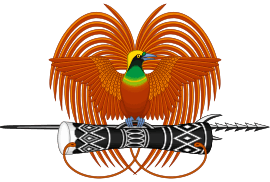Education in Papua New Guinea
 | |
| Department of Education | |
|---|---|
| National education budget (2016) | |
| Budget | 1242.8 million PGK [1] |
| General details | |
| Primary languages | English, Tok Pisin, Hiri Motu and others |
| System type | Public, religious, private |
| Literacy (2015 est) | |
| Total | 64.2% [2] |
| Male | 65.6% [2] |
| Female | 62.8% [2] |
| Enrollment (2014) | |
| Total | 1,805,000 [3] |
| Primary | 1,427,000 [3] |
| Secondary |
243,000 (Lower) [3] 136,000 (Upper) [3] |
Education in Papua New Guinea is managed through nineteen provinces and two district organisational units. It is tuition-free and attendance is not compulsory. With a literacy rate of 64.2%, Papua New Guinea has the lowest literacy rate in Oceania.
History
The first school in Papua New Guinea was established in 1873 by English missionaries. Missionaries would continue providing the basis for education, with English and German as primary languages. In 1914, as part of World War I, Australia took control over German New Guinea and English became the sole official language.
The Currie Commission was created in 1964 to investigate the establishment of higher education in the Territory of Papua and New Guinea. In 1965 the first university in Papua New Guinea, the University of Papua New Guinea, was established. It was heavily influenced by the Australian education system.[4]
Education in Papua New Guinea has been tuition-free since 2012, as one of the election promises of the People's National Congress.
Provision
Papua New Guinea's history of missionary education has led to a large part of education being provided by religious schools. The Department of Education has estimated that 29% of the country's lower secondary education is operated by churches. 3% is operated by private international schools, while the remainder is funded by the government.
Educational Stages
Papua New Guinea has an A-to-D grading system, with D being a failing grade.
| Age | Level | School | Language | |
|---|---|---|---|---|
| 7 | Introductory | Local community school | Local languages | |
| 8 | ||||
| 9 | Primary | |||
| 10 | ||||
| 11 | ||||
| 12 | ||||
| 13 | Middle | |||
| 14 | ||||
| 15 | Provincial high school | Official languages (English, Tok Pisin, Hiri Motu) | ||
| 16 | ||||
| 17 | Secondary | Vocational (duration varies) |
National high school | |
| 18 | ||||
| 19+ | Tertiary | University | ||
Universities
There are six universities in Papua New Guinea. These are accredited under the PNG Office of Higher Education and have establishing Acts of Parliament. The six universities and the main campus of each are, in alphabetical order:
- Divine Word University in Madang
- Pacific Adventist University in Port Moresby
- University of Goroka in Goroka
- University of Natural Resources and Environment in Vudal with associated campuses in Popondetta, Kavieng and Sepik
- University of Papua New Guinea in Port Moresby
- University of Technology (Unitech) in Lae
Language education
In 2015, Papua New Guinean Sign Language became an official language in PNG. Based on Auslan, it is used in deaf education.
References
- ↑ "Papua New Guinea 2017 National Budget" pwc.com. Retrieved June 14, 2017.
- 1 2 3 "The World Factbook" cia.gov. Retrieved June 14, 2017.
- 1 2 3 4 "Papua New Guinea National Education Profile" Education Policy And Data Center. Retrieved August 23, 2017.
- ↑ Richard Guy, Toshio Kosuge, Rieko Hayakawa (2000). Distance Education in the South Pacific: Nets and Voyages. Institute of Pacific Studies, University of the South Pacific and Pacific Island Nations Fund, Sasakawa Peace Foundation. p. 115
- ↑ "Papua New Guinea Education System" classbase.com. Retrieved November 08, 2017.